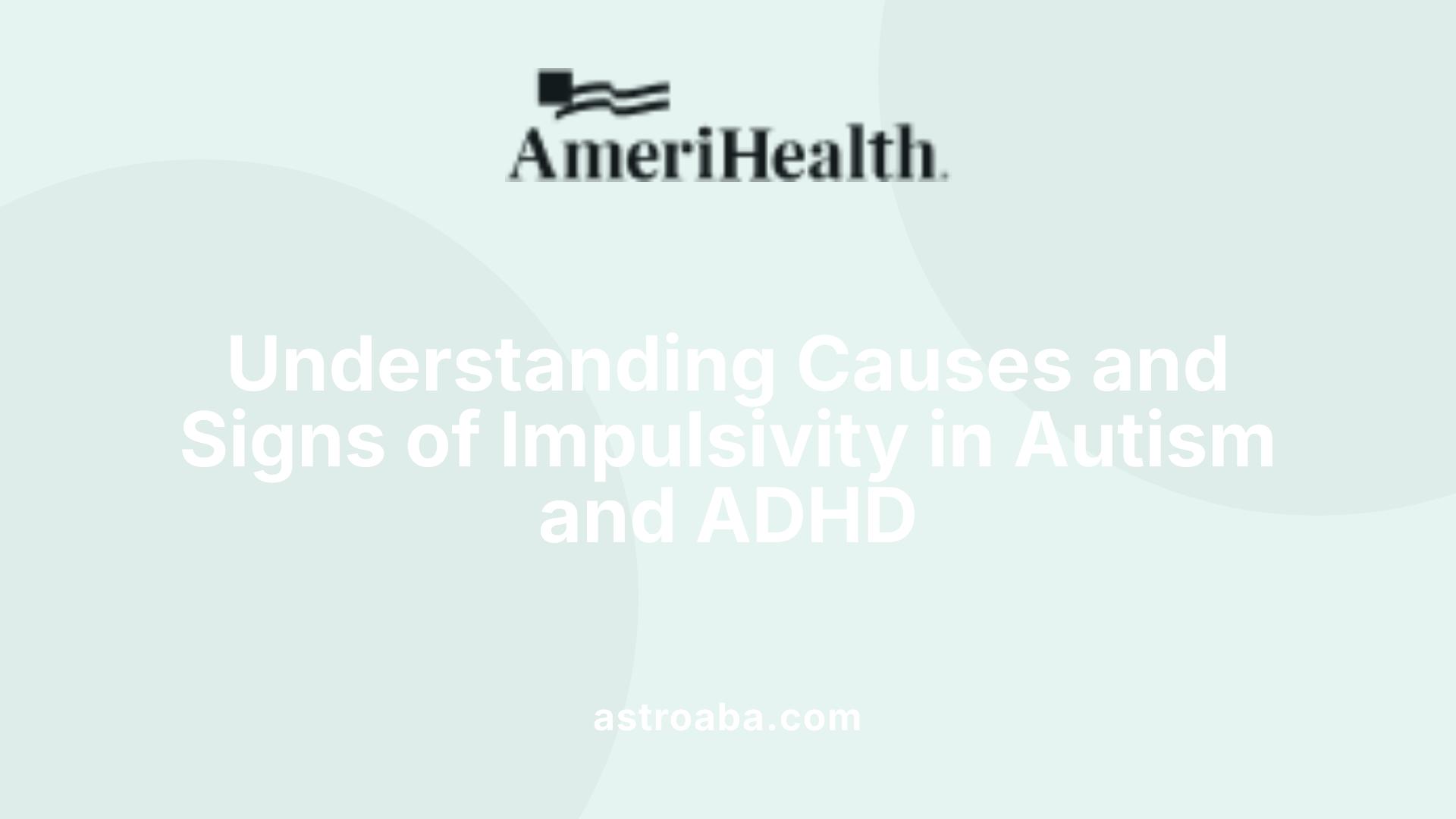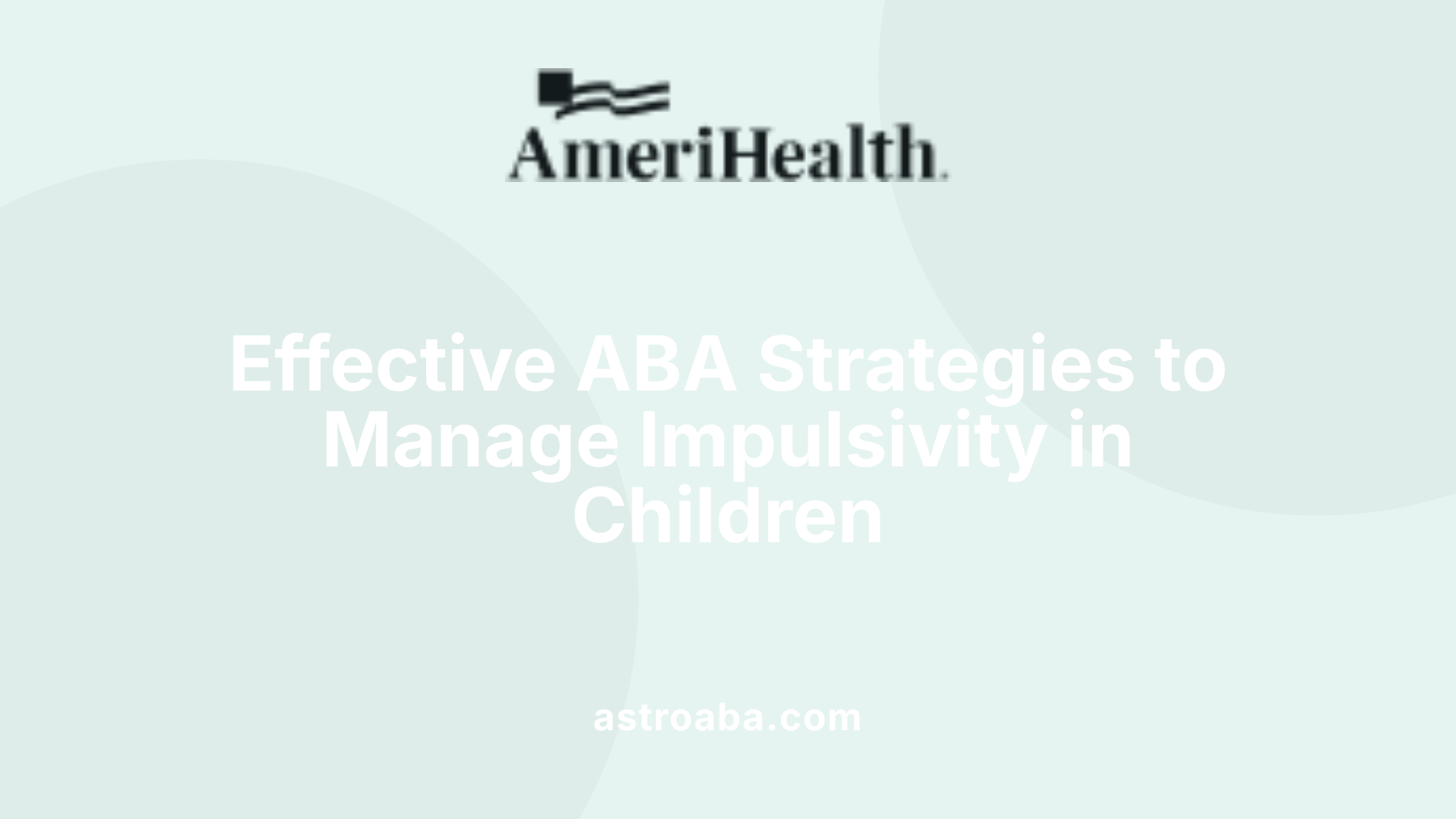How ABA Therapy Can Address Impulsivity in Children
Transforming Child Behavior: The Power of ABA Therapy Against Impulsivity

Understanding Impulsivity in Children with Autism and ADHD
Impulsivity is a common challenge in children with neurodevelopmental conditions such as autism and ADHD. It encompasses behaviors like interrupting, emotional outbursts, and acting without thinking, which can hinder daily functioning and social integration. This article explores how Applied Behavior Analysis (ABA) therapy offers effective, evidence-based strategies to manage and reduce impulsive behaviors, thereby supporting healthier emotional regulation and social skills development.
Causes and Manifestations of Impulsivity in Children with Autism and ADHD

What causes impulsivity in children with autism and ADHD, and how is it manifested?
Impulsivity in children diagnosed with autism and ADHD stems from neurological differences that affect how their brains control responses and regulate behavior. These differences often involve abnormalities in brain regions responsible for self-control, such as the prefrontal cortex, and in neural networks including the anterior cingulate cortex. These areas form part of the brain's response inhibition and executive functioning systems.
Because of these neural differences, children with autism and ADHD may find it challenging to suppress inappropriate responses and to manage their impulses and emotions effectively. This can lead to a variety of disruptive behaviors that impact their daily lives.
Common signs of impulsivity include interrupting conversations, acting without thinking, and difficulty waiting for their turn. Children might also have emotional outbursts, such as tantrums or yelling, and sometimes engage in aggressive behavior or property destruction. In some cases, impulsivity manifests as rapid food or object consumption or self-injury. Because these behaviors can be disruptive and sometimes dangerous, they often require tailored interventions.
It's important to recognize that while some impulsive behaviors are typical in early child development, severe or persistent impulsivity may indicate underlying neurodevelopmental conditions like autism or ADHD. Proper assessment and diagnosis are crucial for developing effective management strategies.
Interventions usually involve behavioral therapies, such as Applied Behavior Analysis (ABA), structured routines, and reinforcement systems. In some cases, medication might be recommended to help manage symptoms, especially when impulsivity is significant or paired with other behavioral challenges.
Children’s unique neurobehavioral profiles mean that a comprehensive, personalized approach is vital. Tailored interventions that focus on developing self-regulation and emotional control are essential for improving overall functioning and quality of life.
Benefits of ABA in Enhancing Impulse Control

What are the benefits of ABA therapy in improving impulse control in children?
Applied Behavior Analysis (ABA) therapy has proven to be highly effective in helping children develop better impulse control. Through the use of evidence-based techniques such as positive reinforcement, prompting, and shaping behaviors, ABA guides children toward healthier responses to their emotions and impulses.
One of the primary advantages of ABA is its ability to identify and address the root causes of challenging behaviors like tantrums, aggression, and self-injury. By understanding what triggers these behaviors, therapists can tailor interventions that teach children more appropriate ways to respond, fostering greater self-awareness and emotional regulation.
ABA also plays a vital role in promoting social skills and effective communication. Children learn to interpret social cues, express their needs appropriately, and interact positively with peers and adults. These skills are essential for reducing impulsive actions that often stem from misunderstandings or frustration.
Furthermore, ABA emphasizes the importance of generalization. Skills learned during therapy sessions, such as impulse control strategies, are practiced and reinforced across various environments, including home, school, and community settings. This consistency ensures that children can apply their new skills in real-life situations, leading to sustained behavioral improvements.
The personalized and data-driven nature of ABA means that interventions are continually adapted based on the child's progress. This tailored approach maximizes effectiveness, supporting children in managing their impulses more effectively over time.
Overall, ABA's comprehensive methodology helps children with impulsivity develop self-regulation skills, reduce disruptive behaviors, enhance social interactions, and apply these improvements broadly across different facets of their lives. This leads to better emotional well-being and functional behavior, enabling children to navigate daily challenges more successfully.
How ABA Addresses Impulsivity in Children with Autism

How does ABA therapy help children with impulsivity issues related to autism?
Applied Behavior Analysis (ABA) therapy is a proven approach for helping children with autism manage impulsive behaviors. It starts with thorough assessments like Functional Behavior Assessments (FBA) to identify what triggers impulsive reactions and to understand the purpose behind these behaviors. By analyzing the antecedent-behavior-consequence patterns, therapists can pinpoint specific environmental cues or emotional states that lead to impulsivity.
Using this detailed information, ABA practitioners develop customized intervention plans tailored to each child's needs. These plans incorporate positive reinforcement techniques, which reward calm and appropriate behaviors, encouraging children to repeat these desirable actions. Key strategies include structured routines, clear instructions, and visual aids to minimize confusion and reduce impulsivity.
A vital part of ABA therapy involves teaching children functional communication skills. Techniques like Functional Communication Training (FCT) give children effective ways to express their feelings and needs, thus decreasing frustration-driven impulsivity. Self-management strategies are also introduced, where children learn to monitor their own behaviors, set personal goals, and use tools like the Stop-Think-Do card to pause before reacting.
Beyond addressing immediate behaviors, ABA focuses on building executive functioning skills like planning, organizing, problem-solving, and impulse control. These abilities are often delayed in children with autism and play a significant role in impulsivity. By practicing real-life tasks and engaging in role-playing exercises, children improve their ability to regulate emotions, patience, and social interactions.
The effectiveness of ABA lies in its structured, data-driven approach. By systematically reinforcing positive behaviors and teaching alternative responses, ABA reduces impulsive actions and enhances emotional regulation. Collaboration with families and educators ensures consistency across environments, reinforcing the child's learning and progress.
Overall, ABA therapy offers comprehensive support that not only mitigates impulsive behaviors but also promotes overall growth in self-control, social skills, and adaptive functioning.
Supporting Children with ADHD through ABA Techniques

How can ABA therapy assist children with ADHD in managing impulsivity?
ABA therapy provides a structured and personalized approach to help children with ADHD control impulsive behaviors. It begins with comprehensive assessments, such as functional behavior assessments and skill evaluations, which identify the specific triggers and patterns of impulsivity. These insights enable therapists to develop tailored strategies targeting each child's needs.
One primary method involves modifying environmental triggers. For example, giving clear instructions, using visual cues, and establishing predictable routines help children understand expectations and reduce unexpected impulses. Pre-correcting potential triggers and matching activities to attention spans prevent situations that might provoke impulsive reactions.
Reinforcement plays a crucial role in ABA. Behavioral techniques such as differential reinforcement (DRA, DRI, DRO) reward positive behaviors and teach alternative, more appropriate responses. Token economies are often used, where children earn tokens immediately for desired behaviors, which can later be exchanged for preferred items or privileges. This approach encourages self-regulation and delay of gratification.
In addition, ABA promotes teaching self-management skills. Children learn to monitor their own behaviors, set achievable goals, and use tools like the Stop-Think-Do card to pause and consider actions before reacting. These self-regulation techniques foster independence and help children develop better impulse control.
Consistent application and collaboration with family and educators are key. Reinforcing strategies across home and school environments ensures that children receive consistent support, increasing the likelihood of positive outcomes.
Overall, ABA combines environmental adjustments, reinforcement strategies, and skill-building exercises to help children with ADHD better manage their impulses. This comprehensive approach not only reduces troublesome behaviors but also supports improvements in social skills, attention, and emotional regulation, leading to improved long-term functioning.
Techniques and Strategies in ABA for Managing Impulsivity

What strategies and techniques are used in ABA therapy to manage impulsivity in children?
ABA therapy incorporates a range of methods to help children control impulsive behaviors and develop self-regulation skills. One fundamental approach involves positive reinforcement, where desired behaviors are consistently rewarded to encourage repetition and foster self-control. For example, children may receive praise, tokens, or other rewards when they demonstrate patience or calming behaviors.
Visual supports are also a staple in ABA, helping children better understand expectations and social cues. Tools such as picture schedules, social stories, and choice boards make routines clearer and reduce confusion, which can trigger impulsive reactions. These supports provide visual cues that guide children to respond appropriately in various situations.
Sensory strategies are employed to help children manage sensory overload—a common challenge in autism. Sensory breaks and designated calming sensory spaces allow children to self-regulate their sensory input, decreasing emotional volatility and impulsivity.
Teaching self-regulation is central to ABA interventions. Children learn techniques like mindfulness, deep breathing, and relaxation exercises to recognize their emotional states and calm themselves. These skills empower children to pause and make deliberate choices instead of acting impulsively.
Consistent routines and structured activities form the backbone of behavioral management. Establishing predictable daily schedules helps children anticipate what comes next, reducing anxiety and impulsive outbursts. Role-playing exercises and social skills training further prepare children for real-life social interactions, giving them practice in appropriate responses.
In summary, ABA combines reinforcement systems, visual aids, sensory strategies, self-regulation techniques, and routine-based interventions to effectively reduce impulsivity and enhance overall behavioral control in children.
Managing Emotional Outbursts and Impulsivity with ABA

How does ABA therapy help manage emotional outbursts and impulsive behaviors?
Applied Behavior Analysis (ABA) therapy offers a structured and effective approach to managing emotional outbursts and impulsivity in children. Central to its success is the identification of individual triggers that lead to emotional or behavioral difficulties. Therapists begin by assessing the child's environment and responses through functional behavior assessments, which pinpoint specific antecedents—events or conditions that set off impulsive reactions.
Once triggers are understood, ABA employs teaching strategies to increase emotional awareness and foster self-regulation. Children are taught to recognize situations that provoke their impulses and to implement coping strategies such as deep breathing, asking for a break, or engaging in calming activities. These interventions are reinforced through positive reinforcement, encouraging children to respond appropriately rather than react impulsively.
Structured routines and goal-setting further support emotional regulation. Breaking down larger challenges into manageable steps helps children develop problem-solving skills and patience, leading to fewer outbursts over time. Techniques like differential reinforcement help reinforce calm behaviors and appropriate responses, gradually replacing impulsive actions.
How do ABA techniques like modeling, role-playing, and functional communication training support emotional regulation?
Modeling and role-playing are key methods used in ABA therapy. By observing modeled behaviors, children learn how to react in specific emotional situations. For example, a therapist might demonstrate calm breathing or polite requests, which the child then practices through role-playing exercises. These methods provide safe environments for children to practice new responses, making it easier to generalize these skills to everyday settings.
Functional Communication Training (FCT) is another vital component. It teaches children to verbally express their feelings, needs, or frustrations instead of resorting to harmful behaviors. For instance, a child who feels overwhelmed might learn to say, “I need a break,” rather than yelling or hitting.
FCT reduces the likelihood of emotional outbursts by equipping children with effective communication tools. When children can articulate their needs, frustration and emotional distress decrease, leading to fewer impulsive reactions.
The importance of consistency and collaboration
For ABA-based strategies to be effective, consistency across different environments such as home, school, and therapy sessions is essential. Collaboration among therapists, family members, and educators ensures that strategies are uniformly applied, reinforcing positive behaviors and emotional regulation skills.
Integrating ABA techniques, like reinforcement, modeling, role-playing, and functional communication, aligns with the goal of helping children develop self-regulation. Over time, these approaches contribute to fewer emotional outbursts and better impulse control, supporting overall behavioral and emotional development.
Empowering Children Through ABA for Better Behavior
ABA therapy offers a structured and effective approach to addressing impulsivity in children. By focusing on individualized assessments, positive reinforcement, skill development, and collaborative support, ABA helps children gain control over their actions, improve emotional regulation, and foster social competence. When consistently applied across home, school, and therapy settings, ABA can significantly enhance quality of life for children with autism and ADHD, paving the way for healthier, more adaptive behaviors.
References
- Autism and Impulse Control: Building Self-Regulation Skills
- ABA Therapy for ADHD Treatment - Manhattan Psychology Group
- From Meltdowns to Calm:ABA Therapy Strategies for Managing ...
- Impulse Control in Autism: What Triggers It and How to Help
- ABA Techniques to Reduce Impulsivity in Kids with ADHD - Five Steps
- ABA Therapy for ADHD: Strategies to Improve Focus & Behavior
- Autism and Impulse Control: Building Self-Regulation Skills
- From Meltdowns to Calm:ABA Therapy Strategies for Managing ...
Recent articles

The Role of Prompting and Fading in ABA Therapy Programs
Enhancing Autism Interventions Through Systematic Support Reduction

The Role of ABA Therapy in Supporting Community Participation
Enhancing Lives Through Community-Focused ABA Interventions

The Role of ABA Therapy in Encouraging Initiative and Motivation
Unlocking Potential: How ABA Empowers Children to Take Initiative

How ABA Therapy Helps Children Develop Initiation and Motivation
Unlocking Potential: The Power of ABA in Fostering Child Independence

How ABA Therapy Encourages Participation in Cooperative Group Activities
Fostering Social Skills Through ABA Interventions

How ABA Therapy Supports Independent Task Initiation in Children
Empowering Children to Begin with Confidence

How ABA Therapy Helps Children Build Resilience in Challenging Situations
Building Emotional Strength Through ABA Therapy

The Impact of ABA Therapy on Reducing Anxiety in Social Settings
Transforming Social Experiences: How ABA Therapy Eases Autism-Related Anxiety

Strategies for Teaching Self-Monitoring Through ABA
Empowering Independence: Techniques to Foster Self-Monitoring with ABA

The Benefits of Combining ABA with Speech and Language Therapy
Integrating Treatment Approaches to Maximize Developmental Progress

Strategies for Teaching Cooperative Problem-Solving Through ABA
Enhancing Collaborative Skills with ABA: Proven Strategies and Techniques

How ABA Therapy Encourages Independent Participation in Daily Tasks
Empowering Autonomy: How ABA Therapy Builds Independence in Daily Life

Creating an Effective Learning Environment at Home for ABA Therapy
Building a Supportive Home Environment for ABA Success

How ABA Therapy Encourages Following Safety Rules at Home and School
Empowering Children with Autism to Follow Essential Safety Rules

How ABA Therapy Encourages Communication Using Gestures and Signs
Enhancing Social Skills with Targeted Gesture Teaching

Common ABA Therapy Techniques for Reducing Aggression
Innovative Strategies in ABA to Minimize Aggressive Behaviors

How ABA Therapy Encourages Communication Using Gestures and Signs
Unlocking the Power of Gestures and Signs in Autism Therapy

How ABA Therapy Encourages Appropriate Social Greetings
Enhancing Social Skills Through Evidence-Based Interventions

Addressing Social Anxiety Using ABA-Based Techniques
Harnessing ABA to Alleviate Social Anxiety

Famous Politicians With Autism
Celebrating Neurodiversity: Insights into Autism and Notable Figures

How ABA Therapy Can Help with Anxiety in Children with Autism
Unlocking Emotional Well-Being: The Power of ABA in Managing Autism-Related Anxiety

The Impact of ABA Therapy on School Success
Enhancing Educational Outcomes with Systematic Interventions

The Importance of Social Stories in ABA Therapy
Harnessing Social Stories to Enhance Social Skills in Autism Interventions

Mild Autism
Understanding the Nuances of Mild Autism

What Are Functional Behavior Assessments (FBA) in ABA Therapy?
Unlocking the Secrets Behind Behavior: The Power of FBAs in ABA

Early Signs Of Autism In Babies And Kids
Recognizing Early Indicators to Support Developmental Health

How to Find Funding for ABA Therapy Services
Unlocking Funding Opportunities for Autism Treatments

How to Help a Child with Autism Transition to ABA Therapy
Supporting Children Through Transition Phases in ABA Therapy

Do Autistic People Get Injured More?
Examining Injury Risks in Individuals with Autism Spectrum Disorder

How ABA Therapy Can Help with Executive Functioning Challenges
Unlocking Skills: The Impact of ABA on Executive Functioning in Autism

What is the Premack Principle in ABA Therapy?
Unlocking Motivation: The Power of the Premack Principle in ABA Therapy

Low-Functioning Autism
Understanding the Challenges and Supports for Low-Functioning Autism

Low-Functioning Autism
Understanding the Challenges and Supports for Low-Functioning Autism

How ABA Therapy Can Help with Playdates and Social Events
Unlocking Social Success: How ABA Therapy Facilitates Playdates and Community Engagement

How ABA Therapy Can Address Impulse Control Issues
Mastering Behavioral Growth: The Power of ABA in Impulse Control

Book, Movie, and TV Characters on the Autism Spectrum
Enhancing Understanding Through Fictional Portrayals

Book, Movie, and TV Characters on the Autism Spectrum
Enhancing Understanding Through Fictional Portrayals

The Role of Visual Supports in ABA Therapy
Enhancing Autism Interventions with Visual Supports

What Is Pervasive Developmental Disorder
Understanding the Spectrum of Developmental Challenges

How ABA Therapy Helps with Emotional Regulation
Empowering Emotional Resilience in Children with Autism

What is Task Analysis in ABA Therapy?
Unveiling the Foundations of Task Analysis in ABA Therapy

How ABA Therapy Can Improve Play Skills
Unlocking Growth: The Power of ABA in Enhancing Play Skills

Air Pollution and Autism
Unveiling the Environmental Impact on Developing Minds

How ABA Therapy Can Help with Bullying Prevention
Building Respect and Resilience Through ABA

How ABA Therapy Can Be Used to Teach Problem-Solving Strategies
Empowering Individuals with Autism Through Targeted Problem-Solving Skills

Can Autistic People Work?
Unlocking Potential: The Realities of Employment for Autistic Individuals

How ABA Therapy Can Help with Homework and Academics
Empowering Academic Success with ABA Therapy

Common Myths About ABA Therapy Debunked
Unmasking Autism Treatment: The Truth About ABA Therapy

Does Aluminum Cause Autism?
Unraveling the Link: Aluminum and Autism Spectrum Disorder

How ABA Therapy Can Support Emotional Expression and Understanding
Unlocking Emotional Growth in Autism Through ABA Therapy

The Role of ABA Therapy in Helping Children Learn Road Safety
Empowering Safe Journeys: How ABA Therapy Fosters Road Safety Skills in Children

The Role of Group ABA Therapy in Social Development
Enhancing Social Skills Through Collective Strategies

What Is Autistic Burnout?
Understanding the Hidden Struggle of Autistic Burnout

How Do You Get An Autistic Child To Keep Their Shoes On?
Mastering Comfort and Compliance with Shoes for Autistic Children

The Role of ABA Therapy in Addressing Food Aversions and Picky Eating
Transforming Mealtimes: How ABA Therapy Supports Children with Autism

How ABA Therapy Can Assist in Reducing Perfectionism and Anxiety
Harnessing Behavioral Science to Ease Perfectionism and Anxiety

What Is Defeat Autism Now?
Unveiling the Roots and Realities of the DAN Movement

How ABA Therapy Can Help Children Develop Conflict Resolution Skills
Building Bridges: Empowering Children with Conflict Resolution Skills through ABA

OCD vs. Autism
Unraveling the Complex Relationship Between OCD and Autism

Temper Tantrums A Sign Of Autism
Understanding the Complex Relationship Between Temper Tantrums and Autism Spectrum Disorder

How to Pass the BCBA Exam
Your Ultimate Guide to Success in the BCBA Exam

Autism and Addiction's Close Connection
Unraveling the Complex Interplay Between Autism and Substance Use

Autism Facial Expressions
Decoding Emotions: The Complex World of Facial Expressions in Autism

How ABA Therapy Can Help Reduce Anxiety Around Doctor and Dentist Visits
Transforming Medical Experiences for Children with Autism

How ABA Therapy Can Help with Navigating Social Media Responsibly
Empowering Safe Online Engagement for Children with Autism through ABA

How to Choose an Autism Charity
Navigating the Spectrum of Support: A Guide to Selecting the Right Autism Charity

What is Precision Teaching in ABA Therapy?
Harnessing Data-Driven Strategies for Skill Mastery

Autism and Obesity
Understanding the Overlap: Autism and the Rising Concern of Obesity

Individualized Education Programs (IEPs) for Autism
Supporting Success: A Comprehensive Guide to IEPs for Children with Autism

How to Integrate ABA Therapy into Everyday Routines
Transforming Daily Life with ABA Strategies

What is Shaping in ABA Therapy?
Understanding the Core of Behavior Shaping in Autism Interventions

Autism vs. ADHD
Understanding the Distinction and Overlap of Neurodevelopmental Disorders

Is RBT Certification Worth It?
Unveiling the Value of RBT Certification in the Field of ABA

How Negative Reinforcement Works in ABA Therapy
Unlocking the Power of Negative Reinforcement in Behavioral Therapy

How to Advocate for ABA Therapy Services in Schools
Navigating Advocacy for School-Based ABA Therapy

How ABA Therapy Can Address Impulsivity in Children
Transforming Child Behavior: The Power of ABA Therapy Against Impulsivity

Understanding the Different Types of ABA Therapy Programs
Exploring the Spectrum of ABA Therapy Approaches

How ABA Therapy Can Address Regression in Autism
Understanding Regressive Autism and the Role of ABA Therapy

High Functioning Autism And Anger
Understanding Emotional Challenges in High-Functioning Autism

Autism and Puberty
Understanding Puberty in Autistic Youth: Challenges and Support Strategies

Challenging Autism Behavior Problems
Navigating the Complex Landscape of Autism-Related Behavioral Challenges

How ABA Therapy Can Help with Sleep Problems
Transforming Bedtime Routines with Evidence-Based Approaches

How ABA Therapy Can Help Improve Cooperation and Compliance
Fostering Respectful Engagement: The Role of ABA in Enhancing Cooperation and Compliance

Eating Disorders And Autism
Unraveling the Complex Relationship Between Autism and Eating Disorders

How Schedules of Reinforcement Work in ABA Therapy
Mastering Reinforcement Patterns to Foster Behavior Change

How to Incorporate ABA Therapy into a Homeschooling Program
Transforming Homeschooling with Evidence-Based Strategies

What Are the Most Common Misconceptions About ABA Therapy?
Unveiling the Truth Behind ABA Therapy: Myths vs. Facts

What is Demand Fading in ABA Therapy?
Demystifying Demand Fading in ABA Therapy

What Are ABA Assessments and How Do They Work?
Understanding the Foundations of ABA Assessments

What is an AAC Device for Autism?
Unlocking Communication: The Power of AAC Devices for Autism

How ABA Therapy Can Help Children Understand and Express Emotions
Enhancing Emotional Understanding Through Evidence-Based Interventions

How To Prevent Autism
Emerging Strategies to Reduce Autism Risk in Children

How ABA Therapy Can Improve Verbal and Nonverbal Communication
Unlocking Communication: The Power of ABA Therapy for Children with Autism

Natural Environment Teaching (NET): How It Helps with Skill Generalization
Unlocking Practical Learning in Natural Settings

What Is Play Therapy For Autism?
Unlocking the Potential of Play in Autism Therapy

How ABA Therapy Can Improve Fine and Gross Motor Skills
Enhancing Movement and Independence Through ABA Strategies

Calming Strategies For Kids With Autism
Understanding and Supporting Calmness in Children with Autism

Autism Evaluation
Comprehensive Insights into Autism Assessment and Diagnosis

How to Support Your Child's ABA Therapy at Home
Empowering Your Child’s Development at Home with ABA Support

Autism Prevalence Increases in Arizona
Rising Autism Rates Signal Changing Landscape in Arizona

